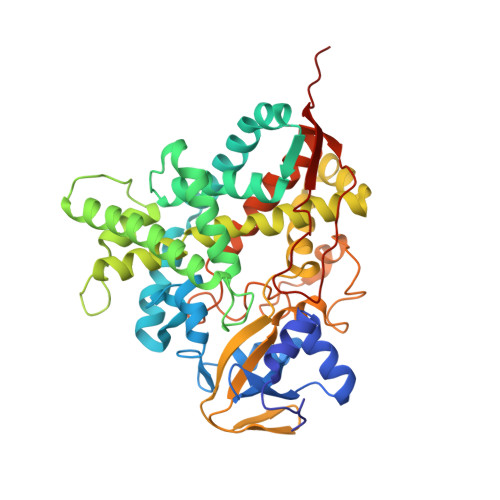Structure and Biochemical Properties of the Alkene Producing Cytochrome P450 OleTJE (CYP152L1) from the Jeotgalicoccus sp. 8456 Bacterium.
Belcher, J., McLean, K.J., Matthews, S., Woodward, L.S., Fisher, K., Rigby, S.E., Nelson, D.R., Potts, D., Baynham, M.T., Parker, D.A., Leys, D., Munro, A.W.(2014) J Biol Chem 289: 6535-6550
- PubMed: 24443585
- DOI: https://doi.org/10.1074/jbc.M113.527325
- Primary Citation of Related Structures:
4L40, 4L54 - PubMed Abstract:
The production of hydrocarbons in nature has been documented for only a limited set of organisms, with many of the molecular components underpinning these processes only recently identified. There is an obvious scope for application of these catalysts and engineered variants thereof in the future production of biofuels. Here we present biochemical characterization and crystal structures of a cytochrome P450 fatty acid peroxygenase: the terminal alkene forming OleTJE (CYP152L1) from Jeotgalicoccus sp. 8456. OleTJE is stabilized at high ionic strength, but aggregation and precipitation of OleTJE in low salt buffer can be turned to advantage for purification, because resolubilized OleTJE is fully active and extensively dissociated from lipids. OleTJE binds avidly to a range of long chain fatty acids, and structures of both ligand-free and arachidic acid-bound OleTJE reveal that the P450 active site is preformed for fatty acid binding. OleTJE heme iron has an unusually positive redox potential (-103 mV versus normal hydrogen electrode), which is not significantly affected by substrate binding, despite extensive conversion of the heme iron to a high spin ferric state. Terminal alkenes are produced from a range of saturated fatty acids (C12-C20), and stopped-flow spectroscopy indicates a rapid reaction between peroxide and fatty acid-bound OleTJE (167 s(-1) at 200 μm H2O2). Surprisingly, the active site is highly similar in structure to the related P450BSβ, which catalyzes hydroxylation of fatty acids as opposed to decarboxylation. Our data provide new insights into structural and mechanistic properties of a robust P450 with potential industrial applications.
Organizational Affiliation:
Manchester Institute of Biotechnology, Faculty of Life Sciences, University of Manchester, Manchester M1 7DN, United Kingdom.















